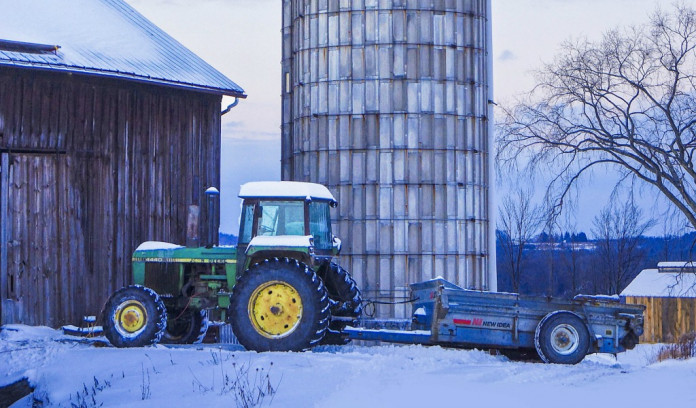As harvest 2016 comes to a close, it’s time to make preparations for proper storage of equipment. It is just as important to do full maintenance and service to your equipment before storing it away for the winter months to prevent rust, corrosion, freezing liquids and many other factors that may deteriorate equipment performance.
1Service checks
Change oil and perform regular service checks to equipment. Clean engine oil reduces internal engine corrosion during storage. Clean or replace air filters, replace fuel filters, lubricate bearings and joints, check antifreeze (like engine oil, antifreeze has a lifespan), and inflate tires. Make sure fuels and fluids are topped of preventing water from entering empty tanks. Plug the tank vent and keep away from heat and direct sunlight.
2Cleaning
Clean out planters, drills, seeders, tillers, balers and combines removing any excess grain, plant material, hay, soil and any other build up. This will reduce rust and improve performance for next season. Grain, hay other material buildup attracts mice and other rodents that will eventually eat electrical wiring. Compressed air and pressure washer are work good for getting in hard to reach places. Be careful to avoid direct contact with seals when using high pressure washers. Used compressed air to dry equipment after washing and operate machinery for 10-20 minutes to help shed excess water.
3Fix damages
Repaint worn surfaces with spray paint to prevent corrosion. Fix any broken parts to prevent further damage or rust or make note of repairs that need attention before spring fieldwork rolls around. This makes for quick access to equipment when it is needed next season.
4Battery storage
Proper battery storage protects batteries from deterioration and leaking. A small current drain can eventually lead to a battery discharge and cause freezing in cold weather. Consider disconnecting or removing batteries to a storage where they can receive periodic charge and clean all connections and coat terminals with a thin layer of grease to prevent corrosion. If you plan to use the equipment in the winter, make sure to periodically check battery charge.
5Store equipment
Equipment should be stored in a shed or building out of the elements. If a building is not available consider investing in a sturdy tarp and cloth covers for computerized devices. Use water resistant products such as wax to protect equipment from rust or wear. This will also improve the resale value of equipment.
Be sure to consult the owner’s manual for any additional post-harvest requirements.
Source: Tips gleaned from the Utah State University Extension and various extension bulletins.
(Farm and Dairy is featuring a series of “101” columns throughout the year to help young and beginning farmers master farm living. From finances to management to machinery repair and animal care, farmers do it all.)
More Farming 101 columns:
- 7 tips for family meetings on the farm
- 4 tips for balancing your farm and family
- 4 tips for communicating on the family farm
- 4 tips for firing an employee
- 6 tips for keeping good farm help
- 4 tips for recruiting farm labor
- 5 general farm labor laws
- 4 tips for employing minors
- 4 tips for PTO safety
- 5 things young farmers should know about finances
- The farm balance sheet
- 5 items for your farm’s cash flow statement
- Personal and business records: Keep them separate
- What to include in your farm business plan
- How to approach a lender: Tips for getting a farm loan
- How to use microloans to get your farm started
- Saving for the future: 6 tips for young farmers
- How to create a farm safety kit
- 5 tips for child safety on the farm
- 4 tips for transporting livestock
- 5 ways to better understand tractor stability
- 6 farm equipment hacks












Great article! In addition to the tips discussed here, a lot of folks in my area throw a few mouse repellent pouches in the cab and engine bay of their equipment. Most folks swear by Top Cat. It works better than anything else I’ve tried. The website is http://www.topcatgoods.com
You made a good point when you mentioned that farming equipment should be stored in a shed. I would think that it would be a good idea to make sure that you have a shed that has enough space to store all of your machinery and equipment. I would think that you would want a large shed so that you can ensure that you have enough space for new items as you collect them.